|
|
| Taoism
or Daoism |
Taoism or Daoism
Taoism (or Daoism) refers to a variety of related
philosophical and religious traditions that have
influenced Eastern Asia for more than two millennia,
and have had a notable influence on the western
world particularly since the 19th century. The
word 道, Tao (or Dao, depending on the romanization
scheme), literally translates as "path"
or "way" (of life), although in Chinese
folk religion and philosophy it carries more abstract
meanings. Taoist propriety and ethics emphasize
the Three Jewels of the Tao: compassion, moderation,
and humility, while Taoist thought generally focuses
on nature, the relationship between humanity and
the cosmos (天人相应), health and longevity, and wu
wei (action through inaction), which is thought
to produce harmony with the Universe. |
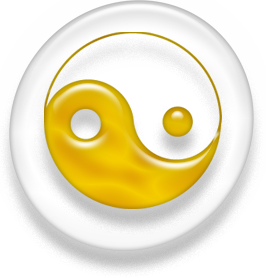 |
|
|
| Reverence for ancestor spirits and immortals is also common in popular Taoism. Organized Taoism distinguishes its ritual activity from that of the folk religion, which some professional Taoists (Daoshi)
view as debased. Chinese alchemy (including Neidan), astrology, cuisine, several Chinese martial arts, Chinese traditional medicine, feng shui, immortality, and many styles of qigong breath training disciplines have been intertwined
with Taoism throughout history. |
|
|
| There
is debate over how, and whether, Taoism should
be subdivided. Livia Kohn divided it into the
following three categories: |
• Philosophical Taoism (Daojia 道家) - A philosophical school based on the texts Dao De Jing (道德經) and Zhuangzi (莊子);
• Religious Taoism (Daojiao 道敎) - A family of organized Chinese religious movements originating from the Celestial Masters movement during the late Han Dynasty and later including the "Orthodox"
(Zhengyi 正一) and "Complete Reality" (Quanzhen 全眞) sects, which claim lineages going back to Lao Zi (老子) or Zhang Daoling in the late Han Dynasty;
• Folk Taoism - The Chinese folk religion.
Taoism does not fall strictly under an umbrella or a definition of an organized religion like the Abrahamic traditions, nor can it purely be studied as the originator or a variant of Chinese folk religion, as much of the traditional
religion is outside of the tenets and core teachings of Taoism. Many have sent wedding invitations for a Taoist wedding ceremony where the couple sits in the center of the Pa kua facing each other.
Robinet asserts that Taoism is better understood as a way of life than as a religion, and that its adherents do not approach or view Taoism the way non-Taoist historians have done. Henri Maspero noted that many scholarly works
frame Taoism as a school of thought focused on the quest for immortality. |
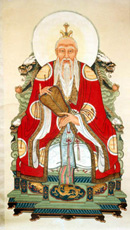 |
|
|
|
Taoism has never been a unified religion, but has rather consisted of numerous teachings based on various revelations. Therefore, different branches of Taoism often have very distinct beliefs. Nevertheless,
there are certain core beliefs that nearly all the sects share.
Principles
Taoist theology emphasizes various themes found in the Daodejing and Zhuangzi, such as naturalness, vitality, peace, "non-action" (wu wei, or 'effortless effort'), emptiness (refinement), detachment, flexibility, receptiveness,
spontaneity, the relativism of human ways of life, ways of speaking and guiding behaviour.
Tao
"Tao" literally means "the way,"
but can also be interpreted as road, channel,
path, doctrine, or line. Wing-tsit Chan stated
that Tao meant a system of morality to Confucianists,
but the natural, eternal, spontaneous, indescribable
way things began and pursued their course to Taoists.
Hansen disagrees that these were separate meanings
and attributes. Cane asserts Tao can be roughly
stated to be the flow of the universe, or the
force behind the natural order, equating it with
the influence that keeps the universe balanced
and ordered.Martinson says that Tao is associated
with nature, due to a belief that nature demonstrates
the Tao. The flow of qi, as the essential energy
of action and existence, is often compared to
the universal order of Tao. Tao is compared to
what it is not, which according to Keller is similar
to the negative theology of Western scholars.
It is often considered to be the source of both
existence and non-existence. LaFargue asserts
that Tao is rarely an object of worship, being
treated more like the Indian concepts of atman
and dharma.
De (Te)
Tao is also associated with the complex concept
of De (德) "power; virtue; integrity",
that is, the active expression of Tao. De is the
active living, or cultivation, of that "way"
Wu wei
Wu wei (simplified Chinese: 无为; traditional
Chinese: 無爲; pinyin: wúwéi) is a central
concept in Taoism. The literal meaning of
wu wei is "without action". It
is often expressed by the paradox wei wu
wei, meaning "action without action"
or "effortless doing". The practice
and efficacy of wu wei are fundamental in
Taoist thought, most prominently emphasized
in Taoism. The goal of wu wei is alignment
with Tao, revealing the soft and invisible
power within all things. It is believed
by Taoists that masters of wu wei can observe
and follow this invisible potential, the
innate in-action of the Way.
In ancient Taoist texts, wu wei is associated
with water through its yielding nature.
Water is soft and weak, but it can move
earth and carve stone. Taoist philosophy
proposes that the universe works harmoniously
according to its own ways. When someone
exerts his will against the world, he disrupts
that harmony. Taoism does not identify man's
will as the root problem. Rather, it asserts
that man must place his will in harmony
with the natural universe.
P'u
P'u (simplified Chinese: 朴; traditional
Chinese: 樸; pinyin: pǔ, pú; Wade-Giles:
p'u; lit. "uncut wood") is translated
"uncarved block", "unhewn
log", or "simplicity". It
is a metaphor for the state of wu wei (無爲)
and the principle of jian (儉). It represents
a passive state of receptiveness. P'u is
a symbol for a state of pure potential and
perception without prejudice. In this state,
Taoists believe everything is seen as it
is, without preconceptions or illusion.
P'u is usually seen as keeping oneself in
the primordial state of tao. It is believed
to be the true nature of the mind, unburdened
by knowledge or experiences. In the state
of p'u, there is no right or wrong, beautiful
or ugly. There is only pure experience,
or awareness, free from learned labels and
definitions. It is this state of being that
is the goal of following wu wei. |
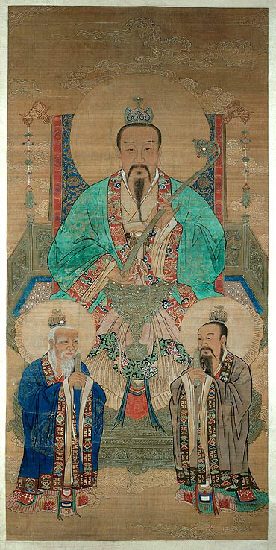 |
Spirituality
Taoists believe that man is a microcosm for the
universe. The body ties directly into the Chinese
five elements. The five organs correlate with
the five elements, the five directions and the
seasons. Akin to the Hermetic maxim of "as
above, so below", Taoism posits that man
may gain knowledge of the universe by understanding
himself.
In Taoism, even beyond Chinese folk religion,
various rituals, exercises, and substances are
said to positively affect one's physical and mental
health. They are also intended to align oneself
spiritually with cosmic forces, or enable ecstatic
spiritual journeys. These concepts seem basic
to Taoism in its elite forms. Internal alchemy
and various spiritual practices are used by some
Taoists to improve health and extend life, theoretically
even to the point of physical immortality. |
|
Ethics
The Three Jewels, or Three Treasures, (Chinese:
三寶; pinyin: sānbǎo; Wade-Giles: san-pao) are basic
virtues in Taoism. The Three Jewels are compassion,
moderation, and humility. They are also translated
as kindness, simplicity (or the absence of excess),
and modesty. Arthur Waley describes them as "The
three rules that formed the practical, political
side of the author's teaching". He correlated
the Three Treasures with "abstention from
aggressive war and capital punishment", "absolute
simplicity of living", and "refusal
to assert active authority".
Sexuality
From a Western perspective, the Taoist view of
sexuality is considerably more at ease. The body
is not viewed as a dangerous source of evil temptation,
but rather as a positive asset. Taoism rejects
Western mind-body dualism; mind and body are not
set in contrast or opposition with each other.
Sex is treated as a vital component to romantic
love, however Taoism emphasizes the need for self-control
and moderation. Complete abstinence is frequently
treated as equally dangerous as excessive sexual
indulgence. The sexual vitality of men is portrayed
as limited, while the sexual energy of women is
viewed as boundless. Men are encouraged to control
ejaculation to preserve this vital energy, but
women are encouraged to reach orgasm without restriction.
Taoists believe that a man may increase and nourish
his own vitality by bringing a woman to orgasm,
thereby "activating" her energy and
attuning it with himself. This is considered to
be of benefit to both partners.
The Chinese government prefers the celibate model
of Buddhism for Taoist clergy; Quanzhen clergy
take vows of celibacy, but Zhengyi clergy are
often married, and often reside at home. They
are called sanju Taoshi, or "Taoist priests
who live at home." Numbering in the tens
of thousands, the sanju Taoshi perform rituals
for their local communities.
You may detect similarities
with certain Hindu beliefs and practices
here.
Scripture
Tao Te Ching
The Tao Te Ching, or Daodejing, is widely
regarded to be the most influential Taoist
text. It is a foundational scripture of
central importance in Taoism purportedly
written by Lao Tzu sometime in the 3rd or
4th centuries BC. However, the precise date
that it was written is still the subject
of debate: there are those who put it anywhere
from the 6th century BC to the 3rd century
BC. It has been used as a ritual text throughout
the history of religious Taoism.
Taoist commentators have deeply considered
the opening lines of the Tao Te Ching. They
are widely discussed in both academic and
mainstream literature. A common interpretation
is similar to Korzybski's observation that
"the map is not the territory".
The opening lines, with literal and common
translation, are:
|
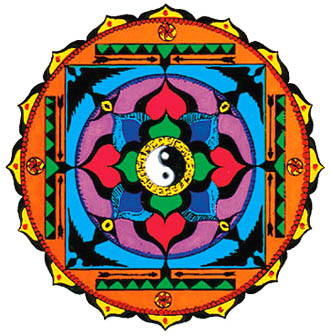 |
道可道,非常道。 [Tao (way or path) can
be said, not usual way]
"The Way that can be described is not the
true Way."
名可名,非常名。 (names can be named, not usual names)
"The Name that can be named is not the constant
Name."
Tao literally means "path"
or "way" and can figuratively
mean "essential nature", "destiny",
"principle", or "true path".
The philosophical and religious "Tao"
is infinite, without limitation. One view
states that the paradoxical opening is intended
to prepare the reader for teachings about
the unteachable Tao. Tao is believed to
be transcendent, indistinct and without
form. Hence, it cannot be named or categorized.
Even the word "Tao" can be considered
a dangerous temptation to make Tao a limiting
"name".
The Tao Te Ching is not thematically ordered.
However, the main themes of the text are
repeatedly expressed using variant formulations,
often with only a slight difference. The
leading themes revolve around the nature
of Tao and how to attain it. Tao is said
to be unnameable and accomplishing great
things through small means.
There is significant debate regarding which
English translation of the Tao Te Ching
is preferred, and which particular translation
methodology is best. Discussions and disputes
about various translations of the Tao Te
Ching can become acrimonious, involving
deeply entrenched views. Ancient commentaries
on the book are important in their own right. |
 |
The Heshang Gong commentary was most likely written
in the second century AD, and as perhaps the oldest
commentary, contains the edition of the Tao Te
Ching that was transmitted to the present day.
Other important commentaries include the Xiang'er,
one of the most important texts from the Way of
the Celestial Masters, and Wang Bi's commentary.
Zhuangzi
The Zhuangzi (莊子) is traditionally attributed
to a Taoist sage of the same name, but this
has recently been disputed in western academia.
Zhuangzi also appears as a character in
the book's narrative. The Zhuangzi contains
prose, poetry, humour and disputation. The
book often is seen as complex and paradoxical
as the arguments and subjects of discussion
are not those common to classical Western
philosophy, such as the doctrine of Name
Rectification (Zhengming) and correctly
making "this/not-this" distinctions
(shi/fei). This also shows influence by
Mohist doctrines. Among the cast of characters
in the Zhuangzi's stories is Laozi of the
Tao Te Ching, as well as Confucius.
|
 |
Daozang
The Daozang (道藏, Treasury of Tao) is sometimes
referred to as the Taoist canon was originally
compiled during the Jin, Tang, and Song dynasties.
The version surviving today was published during
the Ming dynasty. The Ming Daozang includes almost
1500 texts. Following the example of the Buddhist
Tripitaka, it is divided into three dong (洞, "caves",
"grottoes"). They are arranged from
"highest" to "lowest":
The Zhen ("real" or "truth"眞)
grotto. Includes the Shangqing texts.
The Xuan ("mystery"玄) grotto. Includes
the Lingbao scriptures.
The Shen ("divine"神) grotto. Includes
texts predating the Maoshan (茅山)revelations.
Daoshi generally do not consult published versions
of the Daozang, but individually choose, or inherit,
texts included in the Daozang. These texts have
been passed down for generations from teacher
to student.
The Shangqing school has a tradition of approaching
Taoism through scriptural study. It is believed
that by reciting certain texts often enough one
will be rewarded with immortality.
Other Texts
While the Tao Te Ching is most famous, there are
many other important texts in traditional Taoism.
Taishang Ganying Pian ("Treatise of the Exalted
One on Response and Retribution") discusses
sin and ethics, and has become a popular morality
tract in the last few centuries. It asserts that
those in harmony with Tao will live long and fruitful
lives. The wicked, and their descendants, will
suffer and have shortened lives. Both the Tai
Ping Jing ("Scripture on Great Peace")
and the Bao Pu Zi ("Book of the Master Who
Keeps to Simplicity") contain early alchemical
formulas that early Taoists believed could lead
to immortality.
Additionally, the Huainanzi is a compilation of
the writing of eight scholars from Han dynasty
that blends Daoist, Confucianist, and Legalist
concepts, including theories such as Yin-Yang
and the Five Phases. Patron Liu An (c. 180 - 122
BCE) was ruler of the state of Huainan and the
grandson of the founder of the Han dynasty whose
discourse at his court favoured Taoist thought
and who brought philosophers, poets and masters
of esoteric practices to his court. This resulted
in the Huainanzi. |
|
History
Some forms of Taoism may be traced to prehistoric
folk religions in China that later coalesced into
a Taoist tradition. Laozi is traditionally regarded
as the founder of Taoism and is closely associated
in this context with "original", or
"primordial", Taoism. Laozi received
imperial recognition as a divinity in the mid
second century BC Taoism gained official status
in China during the Tang Dynasty, whose emperors
claimed Laozi as their relative. Several Song
emperors, most notably Huizong, were active in
promoting Taoism, collecting Taoist texts and
publishing editions of the Daozang. Aspects of
Confucianism, Taoism, and Buddhism were consciously
synthesized in the Neo-Confucian school, which
eventually became Imperial orthodoxy for state
bureaucratic purposes. The Qing Dynasty, however,
much favoured Confucian classics and rejected
Taoist works. During the eighteenth century, the
imperial library was constituted, but excluded
virtually all Taoist books. By the beginning of
the twentieth century, Taoism had fallen so much
from favor, that only one complete copy of the
Daozang still remained, at the White Cloud Monastery
in Beijing. Taoism is one of five religions recognised
by the PRC, and regulates its activities through
a state bureaucracy (the China Taoist Association).
Adherents
The number of Taoists is difficult to estimate,
due to a variety of factors including defining
Taoism. The number of people practicing Chinese
folk religion is estimated to be just under four
hundred million. Most Chinese people and many
others have been influenced in some way by Taoist
tradition. Estimates for the number of Taoists
worldwide range from twenty to over fifty million.
Taoism as with other religions in China have been
oppressed and discouraged during the Cultural
Revolution, thus the number of Taoists today greatly
declined from the pre-Communist China.
Recently, there have been some efforts to
revive the practice of Taoist religion.
In 1956, the Chinese Taoist Association
was formed, and received official approval
in 1957. It was disbanded during the Cultural
Revolution under Mao, but reestablished
in 1980. The headquarters of the Association
are at Baiyun guan, or White Cloud Temple,
of the Longmen branch of Quanzhen.
Geographically, Taoism flourishes best in
regions populated by Chinese people: mainland
China, Taiwan, Malaysia, Singapore, and
various Chinese diaspora communities. Taoist
literature and art has influenced the cultures
of Korea, Japan, and Vietnam. Organized
Taoism seems not to have attracted a large
non-Chinese following, except in Korea (e.g.
see Kouk Sun Do) and Vietnam, until modern
times. In Taiwan 7.5 million people (33%
of the population) identify themselves as
Taoists. In Singapore, 8.5% of the population
identify themselves as Taoist. There are
also small numbers of Taoists in the Western
world. |
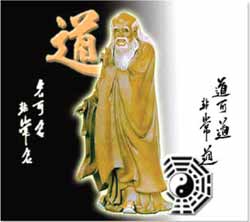 |
Practices
At certain dates, food may be set out as a sacrifice
to the spirits of the deceased and/or the gods,
such as during the Qingming Festival. This may
include slaughtered animals, such as pigs and
ducks, or fruit. Another form of sacrifice involves
the burning of Joss paper, Joss sticks, or Hell
Bank Notes, on the assumption that images thus
consumed by the fire will reappear—not as a mere
image, but as the actual item in the spirit world,
making them available for revered ancestors and
departed loved ones. At other points, a vegan
diet or full fast may be observed.
Also on particular holidays, street parades take
place. These are lively affairs which invariably
involve firecrackers and flower-covered floats
broadcasting traditional music. They also variously
include lion dances and dragon dances; human-occupied
puppets (often of the "Seventh Lord"
and "Eighth Lord"); tongji (童乩 "spirit-medium;
shaman") who cut their skin with knives;
Bajiajiang, which are Kungfu-practicing honour
guards in demonic makeup; and palanquins carrying
god-images. The various participants are not considered
performers, but rather possessed by the gods and
spirits in question.
Fortune-telling including astrology, I Ching,
and other forms of divination has long been considered
a traditional Taoist pursuit. Mediumship is also
widely encountered in some sects. There is an
academic and social distinction between martial
forms of mediumship (such as tongji) and the spirit-writing
that is typically practiced through planchette
writing.
Many Taoists also participate in the study, analysis
and writing of books. Taoists of this type tend
to be civil servants, elderly retirees, or in
modern times, university faculty. While there
is considerable overlap with religious Taoism,
there are often important divergences in interpretation.
For example, Wang Bi, one of the most influential
philosophical commentators on the Laozi (and Yijing),
was a Confucian.
A number of martial arts traditions, particularly
T'ai Chi Ch'uan, Bagua Zhang, Wing Chun, Won Yuen
Yat Hey Jueng, Bak Mei Pai, Bok Fou Pai, Yaw Gong
Moon and Xing Yi Quan, embody Taoist principles
to a greater or lesser extent, and some practitioners
consider their art to be a means of practicing
Taoism.
Taoist symbols and images
The Taijitu ("yin and yang") symbol
太極圖 as well as the Ba gua 八卦 ("Eight Trigrams")
are associated with Taoist symbolism. While almost
all Taoist organizations make use of the yin and
yang symbol, one could also call it Confucian,
Neo-Confucian or pan-Chinese. The yin and yang
make a backwards "S" shape, with yin
(black or red) on bottom. One is likely to see
this symbol as decorations on Taoist organization
flags and logos, temple floors, or stitched into
clerical robes. According to Song Dynasty sources,
it originated around the 10th century. Previously,
yin and yang were symbolized by a tiger and dragon.
Taoist temples may fly square or triangular flags.
They typically feature mystical writing or diagrams
and are intended to fulfill various functions
including providing guidance for the spirits of
the dead, to bring good fortune, increase life
span, etc. Other flags and banners may be those
of the gods or immortals themselves.
A zigzag with seven stars is sometimes displayed,
representing the Big Dipper (or the "Bushel",
the Chinese equivalent). In the Shang dynasty
the Big Dipper was considered a deity, while during
the Han dynasty, it was considered a qi path of
the circumpolar god, Taiyi.
Taoist temples in southern China and Taiwan may
often be identified by their roofs, which feature
Chinese dragons and phoenixes made from multi-coloured
ceramic tiles. They also stand for the harmony
of yin and yang (with the phoenix being yin).
A related symbol is the flaming pearl which may
be seen on such roofs between two dragons, as
well as on the hairpin of a Celestial Master.
In general though, Chinese Taoist architecture
has no universal features that distinguish it
from other structures.
I Ching (The
Book of Changes)
You are unlikely to study Taoism without
coming across references to The Book of
Changes and associated Eight Trigrams. It
is most likely you may become interested
in both and study them also.
The I Ching is a book of traditional wisdom
and guidance, although many use it in association
with trigrams to try and predict the future.
This book is available with dual English
and Chinese text from any good bookshop
in Hong Kong.
Eight Trigrams
Trigrams are one of the earliest ways of
writing, and consist of lines and spaces.
The Eight Trigrams are also known as The
Eight Gates to the Greater World. They have
general meanings plus a whole host of specialised
meaning depending upon how you are using
them. We recommend this website for further
reading:
http://www.egreenway.com/taichichuan/trigram.htm
|
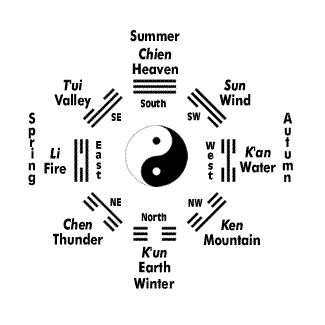 |
Boring is
merely a matter of perspective.
It's a matter of pacing yourself for the
distance.
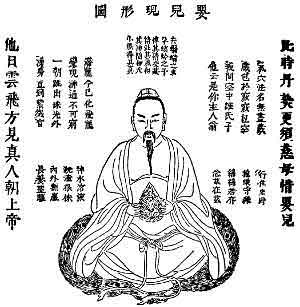 |
Taoism is a practice geared
for your entire life. You don't run full
speed expecting to find all the mysteries
of life in the first few days. Taoism teaches
a person to pace their exploration, discovery
and wandering to cover the path of an entire
life time. So many get excited when first
learning Taoism, only to then lose focus
over time. They put all their energy into
focus of achieving the results they desire
in the now: seemingly in the fewest possible
actions.
The key to a long term Taoist practice is
not about focus, it's about living. People
want short cuts.
Taoism does teach many short cuts... but
the short cuts aren't ones of time, they
are of perception. Taoism provides the tools
of acceptance so it's possible to settle
down and enjoy the run.
Taoism shows a person to take care of mind
, body and spirit so it's possible to run
the distance. Taoism teaches to drop expectations
so a practitioner can have patience to complete
life: to discover it's about yourself rather
than answers. Taoism also teaches that you
will embrace many practices over time, to
match shifting needs. |
| Taoism
is never boring, it's your life. It's just
a question on how we choose to jog through
that life. |
The Third Eye
is a natural part of every person, but it's
a "meta" organ. In other words:
it consists of all the senses and mind working
together as a larger more powerful sensory
organ. The Third Eye is a very clever bit
of natural evolution: a meta organ designed
to sense, connect to patterns and then relay
that data back in overlays of information
on top of your other senses.
Once opened it's a very powerful ability,
powerful enough that it literally can drive
people insane if not understood, accepted
or developed correctly. Also due to lack
of understanding more people than not mislabel,
run away from the ability or take it to
strange descriptions... which further muck
and murk the waters of what the Third Eye
truly is.
The Third Eye as a sense can be used in
many different ways. It opens up our senses
to patterns around us. It's used by seers
to make connections and answer questions.
It's used by energy workers to feel the
energy and then manipulate that energy.
It's part of empathy where a person can
touch and feel the emotions of others. Many
other applications exist for how people
have used the Third Eye. |
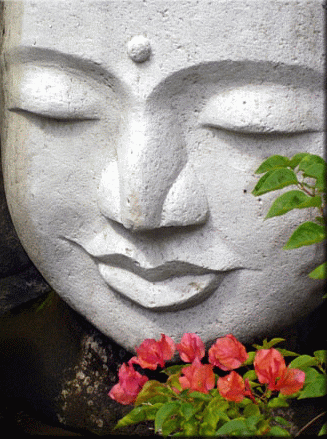 |
The above section is adapted largely
from Casey Kochme's excellent
Taoist website, which is very worth visiting:
http://www.personaltao.com/index.htm
Relations with other religions
and philosophies
Confucianism, Taoism, and Buddhism are one, a
painting in the litang style portraying three
men laughing by a river stream, 12th century,
Song Dynasty.
The terms Tao and De are religious and philosophical
terms shared between Taoism and Confucianism.
The authorship of the Tao Te Ching is assigned
to Laozi, who is traditionally held to have been
a teacher of Confucius. However, some scholars
believe the Tao Te Ching arose as a reaction to
Confucianism. Zhuangzi, reacting to the Confucian-Mohist
ethical disputes in his "history of thought",
casts Laozi as a prior step to the Mohists by
name and the Confucians by implication.
Early Taoist texts reject the basic assumptions
of Confucianism which relied on rituals and order,
in favour of the examples of "wild"
nature and individualism. Historical Taoists challenged
conventional morality, while Confucians considered
society debased and in need of strong ethical
guidance.
The entry of Buddhism into China was marked by
interaction and syncretism, with Taoism in particular.
Originally seen as a kind of "foreign Taoism",
Buddhism's scriptures were translated into Chinese
using the Taoist vocabulary. Chan Buddhism was
particularly modified by Taoism, integrating distrust
of scripture, text and even language, as well
as the Taoist views of embracing "this life",
dedicated practice and the "every-moment".
Taoism incorporated Buddhist elements during the
Tang period, such as monasteries, vegetarianism,
prohibition of alcohol, the doctrine of emptiness,
and collecting scripture in tripartite organisation.
During the same time, Chan Buddhism grew to become
the largest sect in Chinese Buddhism. Christine
Mollier concluded that a number of Buddhist sutras
found in medieval East Asia and Central Asia adopted
many materials from earlier Taoist scriptures.
Ideological and political rivals for centuries,
Taoism, Confucianism, and Buddhism deeply influenced
one another. They also share some similar values,
with all three embracing a humanist philosophy
emphasizing moral behaviour. and human perfection.
In time, most Chinese people identified to some
extent with all three traditions simultaneously.
This became institutionalised when aspects of
the three schools were synthesised in the Neo-Confucian
school.
The extent, or not, of Taoist influence on Western
philosophy is controversial, but some scholars
see Heraclitus, with his distinctive philosophy
of 'change' as reflecting the influence of Taoism,
and there is even a small group of scholars who
see Taoist influence in the philosophy of Plato
and Socrates. Hegel and Schopenhauer both wrote
of Taoism.
Summary
The lines drawn to define customary practice between
Buddhism, Confucianism, and Taoism as largely
those made by scholars, devoted practitioners,
and outside observers. The reality that I have
experienced personally over the 7-years I have
lived in Southeast China, is that ordinary people
everywhere practice "Folk Taoism" during
the course of their daily lives. Most notable
for Western observers would be Qingming Festival,
where ancestors are honoured and remembered. They
are not worshipped. You can read more about these
practices in my missives: Qingming
and Village
Life in Guangdong
Ordinary Chinese people may also perform their
own version of the circumflex when visiting a
temple or shrine, being: to bow three times with
hands set in the pray position. This is most often
accompanied by holding Joss Sticks, and after
bowing, placing these before the shrine. On other
occasions a pendant may be kissed, or a wish sent.
This is definitely not in the Western religious
sense, but more like asking an Angel for help.
A Chinese person would never think to ask for
help on a personal matter, or for a good harvest.
They may wish for this, but do not expect any
divine intervention - simply because it doesn't
work that way.
Most memorable amongst Taoist thinkers is a Buddhist
named Cheung Du. Chinese buddhists do not smoke,
drink alcohol, or eat meat. Cheung Du did, and
sometimes visited a local Taoist temple for retreat.
This crossover is not unique, to the point that
most ordinary Chinese do not even know what faith
they follow, they simply follow their traditional
values and respect their ancestors. That simple.
|
|
|
|
|
Please Note:
The main text of this article is as edited and adapted
by China Expats from the excellent Wikipedia, and is
reproduced under Collective Commons licence:
http://en.wikipedia.org/wiki/Taoism
Pronunciation and Writing:
Please remember that Romanisation of Chinese characters
is not easy, and with Taoism in particular it becomes
most complex because many words written in English that
the world at large understands - are in fact based on
Traditional Chinese characters from Hong Kong or Taiwan
- and even Korea or Vietnam! Mainland Cantonese Romanisation
is not the same, and then there is also the mainstream
Mandarin version. Therefore you should accept that:
Cheung Zi is Hong Kong spelling; Zheng Zhi is Mainland
Cantonese ('e' being pronounced 'u' almost); and Zhang
Zi is Mandarin. Zhuang Zi is Taiwan spelling in English
- - - and they all write both characters as one word
in English. Whichever one you personally prefer, the
Chinese characters remains the same.
You could say this is one aspect of the many facets
of ways of life in modern Southeast Asia? |
|
 |
Tao Directory - Taoism and the Taoist
Arts
Welcome to Tao Directory, where you'll find links
to everything related to Taoism and the Taoist
Arts. A journey of a thousand miles begins with
a single click... |
|
|
This information is as supplied by Wikipedia, as dated
May 2010 or later, and/or other reliable sources.
Disclaimer:
Please check this information yourself as it may alter
without notice, and whilst we try our best to ensure
it is correct, please do not hold us responsible for
any errors - this is intended as a simple guide only |
|
| Our
Friends |

English translations of articles
relating to women's issues. Practical advice on health,
fitness, folk art, shopping, fashion provide a closer
look at Chinese culture |

Professional
Visa Services
Company
Formation Packages
.
|
Excellent
& Free Online Chinese Language Portal

Thousands of free print-friendly Chinese reference sheets,
tests and revision aids.
Easy Learning format &
Listen to Spoken Words |

British Foreign Office
Resource and Advice for Travellers Worldwide |

Chinese Embassy in UK
Information About China
International Relations
Visa & Consular |

UK Embassy in China
Information About UK
International Relations
Visa & Consular |

Excellent and relaxing base to
explore this most beautiful of regions in all China! |
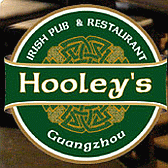 |

Based in Shangri-la,
Yunnan
Province
Dedicated to Exploring Remote Areas of China
Committed to Nature Conservation and Preserving Ethnic
Cultures & Traditions
|
Poppa Wang's Pies
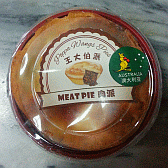
Made in China by an expat, using 100% kosher ingredients, delivered to your door by express courier 
Immediate delivery:
Meat, Aussie, & Veg Pies; Bacon cures, Ham joints, Pork Pies, & Sausages.
Tel: +86 18607566800
Email: poppawangs@gmail.com |

The website of my good friend, and editor, and well worth a look. |
Down The Road.org
How
We Traded Our Ordinary Lives For a Global Bicycle Touring
Adventure

See
Us in China |
|